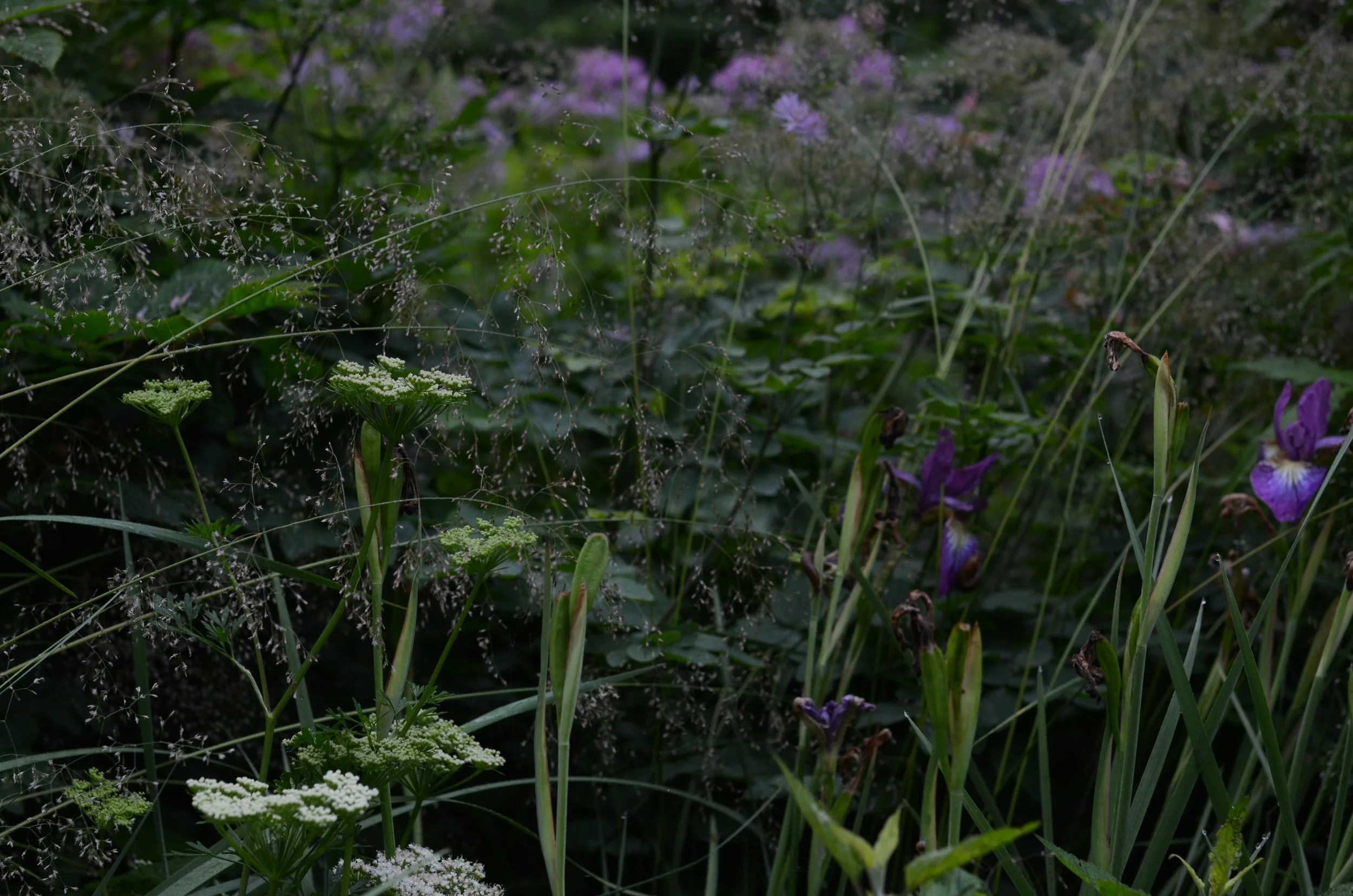ornamental grasses
For me, grasses hold an essential place within any planting scheme. They can carry presence or move quietly in the background, but without them, the composition feels unfinished. Their character shifts, always bringing a quiet rhythm through the planting. When we first planted the garden in September 2021, I drew together a scheme that included an array of ornamental grasses - Deschampsia, Molinia, Melica - each chosen for their looseness, their ungoverned movement. Yet as the garden has settled, I’ve come to see the value of balance - the need for a few more disciplined forms to counter the informality of the perennials that weave through the beds. Molinia, in particular, has given the garden a delicacy - a grass that i feel rules quietly over many others. Its fine stems form a silk-like veil; when you focus on it, there’s an intricate complexity, yet when you look through it, it softens and dissolves, folding seamlessly into the planting around it.
I’ve also long admired Deschampsia - it brings early interest, rising alongside plants such as Iris sibirica ‘Papillon’, Cenelopium dentatum, Thalictrum 'black stockings' and Lilium martagon ‘Pink morning’. Yet over the years I’ve found it to be somewhat temperamental - a give and take for its fine, feathery plumes that shine in early summer. By mid-season here at Ty Gardd, it can dry out in areas, losing the lushness and strength it carried through spring. I often find it growing wild in the surrounding landscape, gathered en masse on damp ground at woodlands edge, and I’ve come to realise that the planting beds here can’t quite offer the consistent moisture it needs to stay lush in places, especially more in the open. Beneath a tree canopy, or in the shade of taller perennials I find it far happier, for it would retain some moisture. For now, I’m slowly lifting it from the beds when required, replacing it with more dependable and resiliant species.
In this article i am focusing on Calamagrostis ‘Karl foerster’, a grass I had initially shied away from due to its strict, architectural form - worried it might contrast too abruptly with the informality within the planting beds and the ideology of the distant Deschampsia that stitches the surrounding landscape. I managed to create thirteen 3L plants from a mature clump earlier this Autumn, this opportunity provided me a moment to rethink the backs of the large planting bed that runs alongside the terrace, currently the Doellingeria umbellata and Veronicastrum virginicum ‘album’ have begun to openly spray and lean due to the rain and wind, an informal mess but one i quite enjoy at this time of year. My thought process is to use the Calamagrostis ‘Karl foerster’ to anchoir the beds, providing a support that nestles amoungst and within these leggy, end of season perennials.
Calamagrostis ‘Karl Foerster’ is a hybrid between C. arundinacea and C. epigejos, both native to Europe and parts of Asia, carrying with it the character of both woodland edge and open meadow. It’s a grass that feels adaptable and quietly resilient, standing upright through wind and rain - steady, dependable, and full of quiet assurance.
At this time of year, the planting still feels full and characterful, carrying with it a memory of the seasons passed - a quiet record of what has worked, what’s been missed, and what could be added. To visualise where the Calamagrostis would best sit, we used coppiced hazel branches cut to roughly their mature height, giving a clear sense of proportion and placement before trapsing the grasses through the beds to plant. This process allows a moment to pause, to step back and see how they converse with the surrounding planting. Calamagrostis has a strong, upright character - it can form a screen if used too heavily - but our intention was for it to lend structure without solidity. We grouped them in loose, parent clusters, allowing smaller drifts to taper away, creating a sense of movement and openness - a natural rhythm where the surrounding plants feel part of the grasses, rather than hidden behind them.
Among ornamental grasses, few offer such graceful seasonal progression as C. Karl Foerster. In spring, it rises early - tight green clumps setting a quiet rhythm within the beds. By early summer, its feathery plumes catch the light and sway with the breeze, moving with an ease and confidence. As summer fades to autumn the tall stems bleach to golden straw, standing firm and skeletal - a disapline through calmness and offering restraint where others wander, its presence solid and dependable, not invasive, not unsteady, but steadfast.
I look forward to the coming years.
